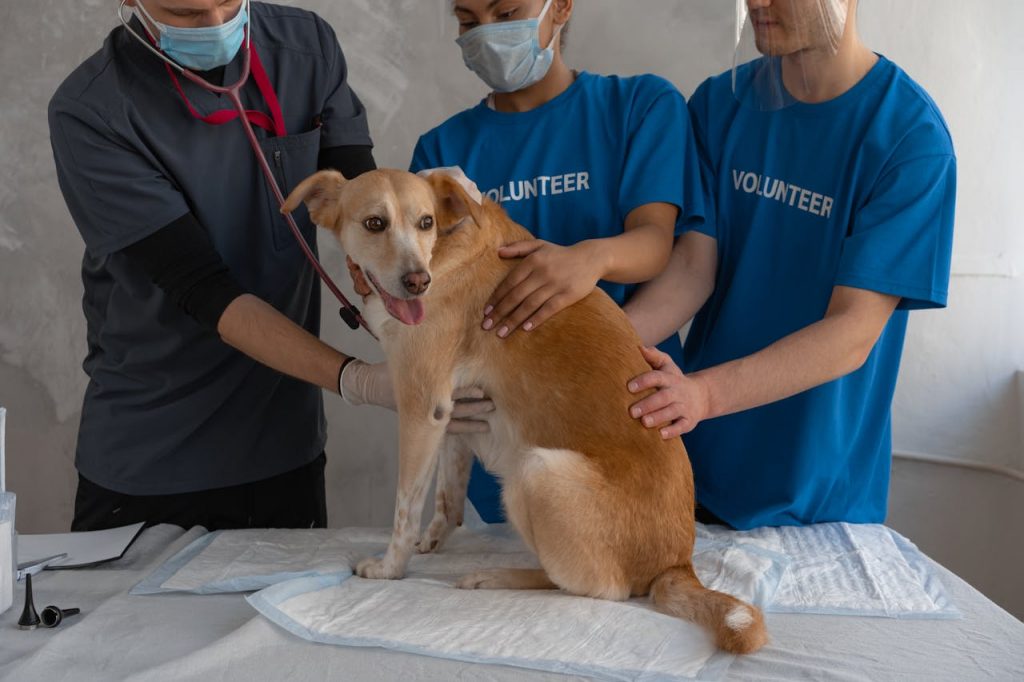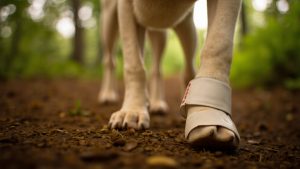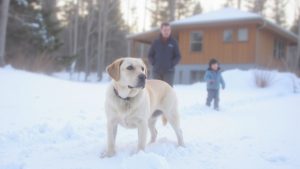
When a Dachshund suddenly yelps in pain and becomes reluctant to move, it may signal intervertebral disc disease (IVDD), a condition that affects thousands of dogs annually.
IVDD occurs when the cushioning discs between spinal vertebrae deteriorate and either bulge or burst, putting pressure on the spinal cord and surrounding nerves. This compression can cause varying degrees of pain, mobility issues, and in severe cases, paralysis.
Though particularly common in breeds with long backs and short legs like Dachshunds and Corgis, IVDD can affect any dog regardless of breed or size.
What is IVDD?
IVDD (intervertebral disc disease) occurs when cushioning discs between the vertebrae in a dog’s spine deteriorate and either bulge or rupture. These discs normally function as shock absorbers, allowing spine flexibility while protecting the spinal cord. When they fail, disc material can press against the spinal cord, causing inflammation, pain, and potentially serious neurological problems.
The structure of these discs resembles a jelly donut – with a tough outer layer (annulus fibrosus) and a gel-like center (nucleus pulposus). In dogs with IVDD, this structure breaks down. The disease typically takes one of two forms: either the center bursts through the outer layer (extrusion), or the entire disc bulges outward (protrusion). Both types can create pressure on the spinal cord and nerves.
Chondrodystrophic breeds – those with a genetic abnormality affecting cartilage development – face the highest risk of developing IVDD. These dogs include Dachshunds, Beagles, Basset Hounds, Shih Tzus, French Bulldogs, and Pembroke Welsh Corgis. Their genetic makeup causes rapid disc degeneration, with calcification beginning as early as 4 months of age. In most dogs, this is an age-related change that happens gradually over many years.
Why Are Some Dogs More Prone to It?
These breeds are particularly vulnerable due to their physical structure. Short legs and long backs create additional strain on their spinal columns. Dachshunds are especially predisposed, with research showing approximately 25% will develop clinical IVDD during their lifetime. Among Dachshund varieties, standard wirehaired Dachshunds appear to have lower risk than the standard and miniature smooth-coated or longhaired varieties.
Larger breeds like German Shepherds, Labrador Retrievers, and Doberman Pinschers can also develop IVDD, though typically in a different form. In these dogs, discs degenerate more slowly over time, usually developing symptoms after age 5. Their disc disease often involves gradual bulging rather than sudden herniation.
Beyond breed predisposition, several other factors influence IVDD risk. Obesity places extra stress on the spine, while poor body condition can reduce muscular support. Some dogs inherit a tendency for more rapid disc degeneration from their parents. Even with genetic predisposition, environmental triggers like jumping off furniture, rough play, or sudden twisting movements can precipitate an IVDD episode in dogs with already weakened discs.
What Are the Early Signs and Symptoms of IVDD in Dogs?

Detecting intervertebral disc disease early can dramatically improve outcomes for affected dogs. Initial signs of IVDD often appear subtle, but recognizing them promptly allows for faster intervention and better recovery chances.
Early Warning Signs
Watch for these indicators that could signal developing spinal issues:
- Reluctance or refusal to jump up or down
- Hesitation when climbing or descending stairs
- Yelping or crying out when moving or being touched
- Stiffness in the neck or back
- Abnormally arched or hunched posture
- Tense abdominal muscles
- Shivering or trembling, especially when standing
Moderate to Severe Symptoms
As the condition progresses, more noticeable mobility and neurological issues emerge:
- Uncoordinated walking or stumbling (appearing drunk or wobbly)
- Weakness in the hind legs
- Dragging one or more paws when walking
- Walking on knuckles or tops of paws
- Partial or complete loss of bladder or bowel control
- Inability to feel pain in the limbs
- Partial or complete paralysis, typically beginning in the hind legs
Behavioral Changes to Monitor
Dogs experiencing pain often demonstrate less obvious behavioral shifts indicating discomfort:
- Decreased appetite or reluctance to eat
- Unexpected aggression when touched in certain areas
- Withdrawal from normal activities or interaction
- Unusual anxiety or restlessness
- Panting without physical exertion or heat
- Changes in sleeping positions or inability to get comfortable
- Reluctance to be picked up or handled
Symptoms can develop gradually or appear suddenly, depending on whether disc degeneration is slow or if a disc ruptures acutely. A dog that was normal yesterday might suddenly yelp and become immobile after a seemingly minor movement.
Pain Indicators Based on Disc Location
The location of the affected disc determines which symptoms appear:
- Neck (cervical) region: Neck pain, reluctance to turn the head, and front limb weakness
- Mid-back (thoracic) region: Difficulty walking, weakness or paralysis in hind legs
- Lower back (lumbar) region: Hind limb weakness, difficulty rising from a lying position
If a dog displays any combination of these symptoms, particularly if they appear suddenly or worsen rapidly, contact a veterinarian immediately. Time is critical with IVDD—a condition that seems like simple stiffness today could progress to paralysis within hours or days. Even mild symptoms warrant prompt veterinary attention, as early intervention significantly improves prognosis.
How Is IVDD in Dogs Diagnosed and Treated?
When a dog is brought to the veterinarian with suspected IVDD, the diagnostic process generally follows specific steps to confirm the condition and determine its severity. Understanding this process can aid in preparing for the dog’s treatment journey.
Diagnosing IVDD
Veterinarians use examination techniques and imaging tools to accurately diagnose IVDD:
- Physical and neurological examination – The vet will assess the dog’s reflexes, ability to feel pain in the limbs, muscle tone, and coordination.
- X-rays – While standard X-rays cannot directly show disc material pressing on the spinal cord, they can reveal narrowed disc spaces or calcified discs indicating potential issues.
- Advanced imaging – For a definitive diagnosis, the veterinarian may recommend:
- MRI (Magnetic Resonance Imaging) – Provides detailed views of the spinal cord and surrounding soft tissues
- CT scan (Computed Tomography) – Offers visualization of bone structure and can pinpoint the location of disc material
- Myelography – A specialized X-ray technique where contrast dye is injected around the spinal cord to highlight compression areas
These diagnostic tools help veterinarians identify the exact location of the damaged disc, assess spinal cord compression, and create an appropriate treatment plan for the dog’s situation.
Treatment Options for IVDD
Treatment recommendations depend largely on the severity of the dog’s symptoms and the extent of spinal cord compression. Options range from conservative management to surgical intervention:
Conservative Management for Mild Cases
Dogs with mild symptoms or first-time episodes may respond well to non-surgical treatment including:
- Strict crate rest – Usually for 4-6 weeks to allow disc healing and inflammation reduction
- Pain management – Medications such as gabapentin or prescription pain relievers
- Anti-inflammatory medication – To reduce swelling around the spinal cord
- Muscle relaxants – To ease muscle spasms that often accompany IVDD
During this period, activity is restricted to short leash walks for bathroom breaks. This rest period is crucial—premature activity can lead to setbacks.
Surgical Intervention for Severe Cases
Surgery is necessary when a dog shows:
- Severe or worsening pain unresponsive to medication
- Loss of ability to walk
- Loss of bladder or bowel control
- Progressive neurological deficits
Common surgical procedures include:
- Hemilaminectomy – Removal of a portion of vertebral bone to access and remove disc material pressing on the spinal cord (commonly used for thoracolumbar IVDD)
- Ventral slot procedure – A technique for neck (cervical) disc issues
- Fenestration – Preventive procedure sometimes done alongside decompression surgery to reduce future disc herniation risk
Timing is critical with surgical intervention. Studies indicate that dogs with complete limb function loss have better outcomes when surgery occurs within 24-48 hours of symptom onset.
Post-Treatment Recovery and Rehabilitation
Recovery from IVDD, whether managed conservatively or surgically, often requires dedicated rehabilitation:
- Physical therapy – Includes passive range of motion exercises, controlled walking, and exercises to rebuild strength and coordination
- Hydrotherapy – Underwater treadmill therapy provides resistance while reducing weight-bearing stress on the spine
- Acupuncture – May assist with pain management and neurological recovery in some cases
- Bladder management – Dogs with paralysis may need manual bladder expression until function returns
For dogs with permanent mobility challenges, mobility aids such as dog wheelchairs (carts) can improve quality of life, allowing them to remain active and engaged.
Can IVDD Be Prevented or Managed Long-Term?

While genetics and age are significant factors in IVDD that can’t be altered, several preventive strategies can reduce a dog’s risk and help manage the condition effectively. Creating a spine-friendly environment is essential, especially for at-risk breeds like Dachshunds and Corgis.
Preventive Care Strategies
Weight management is a crucial preventive measure. Extra pounds put unnecessary pressure on the spine, significantly increasing the risk of disc problems. Collaborate with a veterinarian to establish a healthy weight target and appropriate diet plan for the dog.
Modifying the home environment can dramatically reduce spinal stress. Install pet ramps or stairs to help the dog access beds, couches, and cars without jumping. This adjustment prevents the jarring impact that can trigger disc issues in predisposed dogs. For areas with slippery flooring, add non-slip mats or runners to provide secure footing and prevent falls that could injure the spine.
Exercise selection also matters significantly. Choose activities that strengthen the dog’s core muscles without putting stress on their back. Walking on level ground, swimming, and controlled leash exercise are excellent options. Avoid activities that involve sharp turns, jumping, or rough play that could stress the spine.
Long-Term Management for Dogs with IVDD
For dogs who have already experienced an IVDD episode, ongoing management is essential to prevent recurrence and maintain quality of life. Regular veterinary checkups help monitor the dog’s condition and allow for early intervention if symptoms return.
Physical therapy and rehabilitation exercises can significantly improve outcomes for IVDD dogs. These might include controlled walking, balance exercises, massage, and gentle stretching to maintain mobility and muscle tone. Many rehabilitation centers also offer underwater treadmill therapy, which provides exercise with minimal spinal impact.
Home modifications become even more critical for dogs recovering from or living with IVDD. In addition to ramps and non-slip surfaces, consider using a supportive dog harness during walks for better control and to prevent falls. For severely affected dogs, mobility carts (dog wheelchairs) can restore independence and allow for continued activity despite rear limb weakness or paralysis.
Daily Care Considerations
Consistent daily routines help manage IVDD long-term. Provide firm, supportive bedding that doesn’t sag, potentially increasing spinal strain. Monitor the dog closely during all activities, particularly when navigating stairs or engaging in play. For dogs with limited mobility, regular repositioning prevents pressure sores and maintains comfort.
With appropriate preventive measures and dedicated management, many dogs with IVDD can maintain an excellent quality of life. The key lies in understanding the dog’s specific needs, working closely with a veterinary team, and remaining vigilant for any changes that might indicate a recurrence of symptoms.
IVDD in Dogs: Proactive Steps for Lasting Spinal Health

Intervertebral disc disease is a serious but manageable challenge, and staying informed is the first line of defense. Understanding IVDD risk factors, recognizing early warning signs, and making adjustments in a dog’s home and daily routines set the stage for a healthier life. With smart preventive strategies including ramps, proper weight management, and safe, low-impact exercise, the likelihood of injury or recurrence in vulnerable breeds can be greatly reduced.
Modern solutions like the Halo Collar provide peace of mind for those managing IVDD. Featuring GPS-enabled smart boundaries and real-time activity monitoring, Halo encourages controlled exercise while reducing sudden twists that could affect the spine. Integrating such technology into an IVDD prevention toolkit ensures a dog can explore securely and confidently.
For expert advice on supporting a dog’s health, visit the Dog Health page for valuable tips for every stage of life.





